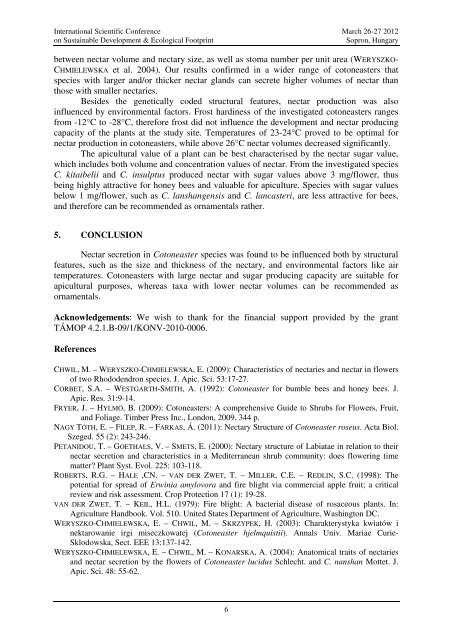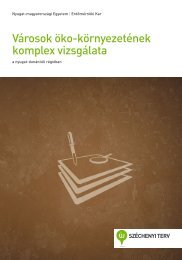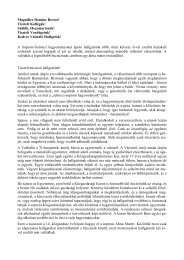Floral Nectar Production and Nectar Sugar Composition of ...
Floral Nectar Production and Nectar Sugar Composition of ...
Floral Nectar Production and Nectar Sugar Composition of ...
Create successful ePaper yourself
Turn your PDF publications into a flip-book with our unique Google optimized e-Paper software.
International Scientific Conference March 26-27 2012<br />
on Sustainable Development & Ecological Footprint Sopron, Hungary<br />
between nectar volume <strong>and</strong> nectary size, as well as stoma number per unit area (WERYSZKO-<br />
CHMIELEWSKA et al. 2004). Our results confirmed in a wider range <strong>of</strong> cotoneasters that<br />
species with larger <strong>and</strong>/or thicker nectar gl<strong>and</strong>s can secrete higher volumes <strong>of</strong> nectar than<br />
those with smaller nectaries.<br />
Besides the genetically coded structural features, nectar production was also<br />
influenced by environmental factors. Frost hardiness <strong>of</strong> the investigated cotoneasters ranges<br />
from -12°C to -28°C, therefore frost did not influence the development <strong>and</strong> nectar producing<br />
capacity <strong>of</strong> the plants at the study site. Temperatures <strong>of</strong> 23-24°C proved to be optimal for<br />
nectar production in cotoneasters, while above 26°C nectar volumes decreased significantly.<br />
The apicultural value <strong>of</strong> a plant can be best characterised by the nectar sugar value,<br />
which includes both volume <strong>and</strong> concentration values <strong>of</strong> nectar. From the investigated species<br />
C. kitaibelii <strong>and</strong> C. insulptus produced nectar with sugar values above 3 mg/flower, thus<br />
being highly attractive for honey bees <strong>and</strong> valuable for apiculture. Species with sugar values<br />
below 1 mg/flower, such as C. lanshangensis <strong>and</strong> C. lancasteri, are less attractive for bees,<br />
<strong>and</strong> therefore can be recommended as ornamentals rather.<br />
5. CONCLUSION<br />
<strong>Nectar</strong> secretion in Cotoneaster species was found to be influenced both by structural<br />
features, such as the size <strong>and</strong> thickness <strong>of</strong> the nectary, <strong>and</strong> environmental factors like air<br />
temperatures. Cotoneasters with large nectar <strong>and</strong> sugar producing capacity are suitable for<br />
apicultural purposes, whereas taxa with lower nectar volumes can be recommended as<br />
ornamentals.<br />
Acknowledgements: We wish to thank for the financial support provided by the grant<br />
TÁMOP 4.2.1.B-09/1/KONV-2010-0006.<br />
References<br />
CHWIL, M. – WERYSZKO-CHMIELEWSKA, E. (2009): Characteristics <strong>of</strong> nectaries <strong>and</strong> nectar in flowers<br />
<strong>of</strong> two Rhododendron species. J. Apic. Sci. 53:17-27.<br />
CORBET, S.A. – WESTGARTH-SMITH, A. (1992): Cotoneaster for bumble bees <strong>and</strong> honey bees. J.<br />
Apic. Res. 31:9-14.<br />
FRYER, J. – HYLMÖ, B. (2009): Cotoneasters: A comprehensive Guide to Shrubs for Flowers, Fruit,<br />
<strong>and</strong> Foliage. Timber Press Inc., London, 2009. 344 p.<br />
NAGY TÓTH, E. – FILEP, R. – FARKAS, Á. (2011): <strong>Nectar</strong>y Structure <strong>of</strong> Cotoneaster roseus. Acta Biol.<br />
Szeged. 55 (2): 243-246.<br />
PETANIDOU, T. – GOETHALS, V. – SMETS, E. (2000): <strong>Nectar</strong>y structure <strong>of</strong> Labiatae in relation to their<br />
nectar secretion <strong>and</strong> characteristics in a Mediterranean shrub community: does flowering time<br />
matter? Plant Syst. Evol. 225: 103-118.<br />
ROBERTS, R.G. – HALE ,CN. – VAN DER ZWET, T. – MILLER, C.E. – REDLIN, S.C. (1998): The<br />
potential for spread <strong>of</strong> Erwinia amylovora <strong>and</strong> fire blight via commercial apple fruit; a critical<br />
review <strong>and</strong> risk assessment. Crop Protection 17 (1): 19-28.<br />
VAN DER ZWET, T. – KEIL, H.L. (1979): Fire blight: A bacterial disease <strong>of</strong> rosaceous plants. In:<br />
Agriculture H<strong>and</strong>book. Vol. 510. United States Department <strong>of</strong> Agriculture, Washington DC.<br />
WERYSZKO-CHMIELEWSKA, E. – CHWIL, M. – SKRZYPEK, H. (2003): Charakterystyka kwiatów i<br />
nektarowanie irgi miseczkowatej (Cotoneaster hjelmquistii). Annals Univ. Mariae Curie-<br />
Sklodowska, Sect. EEE 13:137-142.<br />
WERYSZKO-CHMIELEWSKA, E. – CHWIL, M. – KONARSKA, A. (2004): Anatomical traits <strong>of</strong> nectaries<br />
<strong>and</strong> nectar secretion by the flowers <strong>of</strong> Cotoneaster lucidus Schlecht. <strong>and</strong> C. nanshan Mottet. J.<br />
Apic. Sci. 48: 55-62.<br />
6





